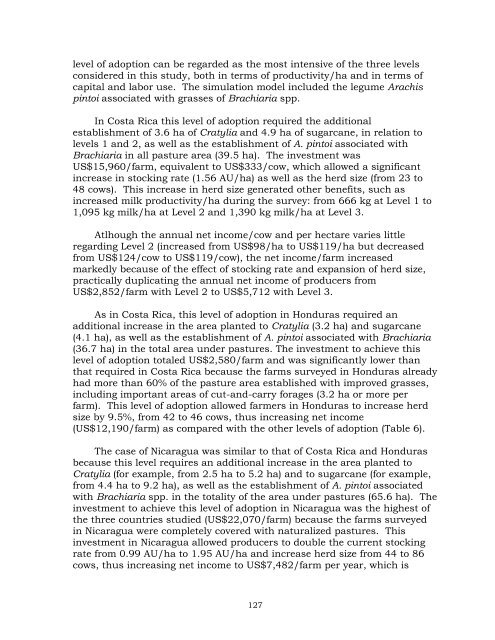Feeding Systems with Legumes to Intensify Dairy Farms - cgiar
Feeding Systems with Legumes to Intensify Dairy Farms - cgiar
Feeding Systems with Legumes to Intensify Dairy Farms - cgiar
Create successful ePaper yourself
Turn your PDF publications into a flip-book with our unique Google optimized e-Paper software.
level of adoption can be regarded as the most intensive of the three levels<br />
considered in this study, both in terms of productivity/ha and in terms of<br />
capital and labor use. The simulation model included the legume Arachis<br />
pin<strong>to</strong>i associated <strong>with</strong> grasses of Brachiaria spp.<br />
In Costa Rica this level of adoption required the additional<br />
establishment of 3.6 ha of Cratylia and 4.9 ha of sugarcane, in relation <strong>to</strong><br />
levels 1 and 2, as well as the establishment of A. pin<strong>to</strong>i associated <strong>with</strong><br />
Brachiaria in all pasture area (39.5 ha). The investment was<br />
US$15,960/farm, equivalent <strong>to</strong> US$333/cow, which allowed a significant<br />
increase in s<strong>to</strong>cking rate (1.56 AU/ha) as well as the herd size (from 23 <strong>to</strong><br />
48 cows). This increase in herd size generated other benefits, such as<br />
increased milk productivity/ha during the survey: from 666 kg at Level 1 <strong>to</strong><br />
1,095 kg milk/ha at Level 2 and 1,390 kg milk/ha at Level 3.<br />
Atlhough the annual net income/cow and per hectare varies little<br />
regarding Level 2 (increased from US$98/ha <strong>to</strong> US$119/ha but decreased<br />
from US$124/cow <strong>to</strong> US$119/cow), the net income/farm increased<br />
markedly because of the effect of s<strong>to</strong>cking rate and expansion of herd size,<br />
practically duplicating the annual net income of producers from<br />
US$2,852/farm <strong>with</strong> Level 2 <strong>to</strong> US$5,712 <strong>with</strong> Level 3.<br />
As in Costa Rica, this level of adoption in Honduras required an<br />
additional increase in the area planted <strong>to</strong> Cratylia (3.2 ha) and sugarcane<br />
(4.1 ha), as well as the establishment of A. pin<strong>to</strong>i associated <strong>with</strong> Brachiaria<br />
(36.7 ha) in the <strong>to</strong>tal area under pastures. The investment <strong>to</strong> achieve this<br />
level of adoption <strong>to</strong>taled US$2,580/farm and was significantly lower than<br />
that required in Costa Rica because the farms surveyed in Honduras already<br />
had more than 60% of the pasture area established <strong>with</strong> improved grasses,<br />
including important areas of cut-and-carry forages (3.2 ha or more per<br />
farm). This level of adoption allowed farmers in Honduras <strong>to</strong> increase herd<br />
size by 9.5%, from 42 <strong>to</strong> 46 cows, thus increasing net income<br />
(US$12,190/farm) as compared <strong>with</strong> the other levels of adoption (Table 6).<br />
The case of Nicaragua was similar <strong>to</strong> that of Costa Rica and Honduras<br />
because this level requires an additional increase in the area planted <strong>to</strong><br />
Cratylia (for example, from 2.5 ha <strong>to</strong> 5.2 ha) and <strong>to</strong> sugarcane (for example,<br />
from 4.4 ha <strong>to</strong> 9.2 ha), as well as the establishment of A. pin<strong>to</strong>i associated<br />
<strong>with</strong> Brachiaria spp. in the <strong>to</strong>tality of the area under pastures (65.6 ha). The<br />
investment <strong>to</strong> achieve this level of adoption in Nicaragua was the highest of<br />
the three countries studied (US$22,070/farm) because the farms surveyed<br />
in Nicaragua were completely covered <strong>with</strong> naturalized pastures. This<br />
investment in Nicaragua allowed producers <strong>to</strong> double the current s<strong>to</strong>cking<br />
rate from 0.99 AU/ha <strong>to</strong> 1.95 AU/ha and increase herd size from 44 <strong>to</strong> 86<br />
cows, thus increasing net income <strong>to</strong> US$7,482/farm per year, which is<br />
127
















